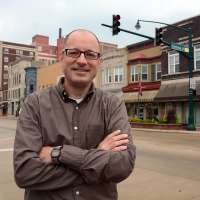Estimated read time: 4-5 minutes
- The Utah Pride Festival starts next week.
- The city's new Sego Belonging flag, featuring a sego lily flower over a rainbow design, was raised Friday in anticipation.
- The Utah Pride Parade, one of the key festival events, will be on June 8.
SALT LAKE CITY — June is Pride Month, Utah Pride Festival activities start in earnest next week and Salt Lake City officials, teaming with Utah Pride Center reps, raised the city's new Sego Belonging Flag on Friday.
The focus on the LGBTQ community fosters empowerment and is "so helpful and powerful to get people motivated and excited again," said Jackson Carter, director of programming and outreach for the Utah Pride Center, an LGBTQ advocacy group that organizes Pride Festival activities. "I think a lot of people are scared right now, and we just want to make people feel happy and excited and welcome."
For the past several years, LGBTQ matters have been a focus of debate in the Utah Legislature, particularly issues related to the transgender community, putting the broader LGBTQ community in the political spotlight. One law passed during the 2025 session earlier this year, HB77, prohibits transgender students from living in single-sex dorms at Utah's public universities that align with their gender identity. Another law forbids the display of pride flags in school classrooms and other public places.
As such, Pride Festival activities serve as a counterweight, a means of celebrating the community in the face of scrutiny that, as LGBTQ advocates see it, can verge on hostility. Actual festival activities are set for Saturday, June 7, and Sunday, June 8. The Utah Pride Parade is set for Sunday morning, concluding a series of other events planned for next week.
The parade, perhaps the highest-profile of Pride Festival activities, "is a party. We are out in the sun and we're loud and colorful and having a great time. And that's what we want, (for) everyone to come and be a part of it and take part of our culture," Carter said. "We're your neighbors and your co-workers and often your children and your family, and we want you to come and take part in this piece of our lives."
While the Utah Pride Parade through downtown Salt Lake City is usually the most visible of festival events, typically drawing tens of thousands of people, the flag-raising ceremony on Friday was noteworthy as well, though for different reasons.
In approving HB77 earlier this year, one of the perceived aims of the measure's proponents was keeping gay pride flags out of school classrooms and other public places, including city government buildings. The new law allows flying of just a limited range of flags, like U.S., state, other governmental banners, but not pride flags or other flags deemed to be too political.
In a move to get around the law, the Salt Lake City Council earlier this month adopted the Pride Progress flag with a sego lily flower on it as one of three official new municipal flags. As an official city flag, HB77 allows it to be flown, and the new rainbow-colored banner, dubbed the Sego Belonging Flag, was raised at the ceremony Friday in recognition of Pride Month, all of June, and the upcoming Utah Pride Festival events.
The city has flown gay pride flags in front of the Salt Lake City-County Building during Pride Month in prior years.
In his years serving the city, Chris Wharton, now a member of the Salt Lake City Council, said he has never heard complaints about the placement of rainbow flags on the poles in front of the city-county building. By raising the Sego Belonging Flag, the city "is going to continue to stand by our values of being a welcoming place, an inclusive place," Wharton said.
Indeed, flying the flag sends a broader message about accepting people because of their differences, not despite them, as he sees it. "I think the message of pride is a message of authenticity," he said.
According to Pew Research Center survey data released Thursday, members of the LGBTQ community sense varying levels of support for subgroups within the population. Among LGBTQ adults surveyed, 61% "say there's at least a fair amount of acceptance for people who are gay or lesbian." That figure falls to just 14% for the nonbinary community and 13% for the transgender community.
Still, most of those surveyed "say there is more acceptance today compared with 10 years ago for each of these groups. And majorities expect there to be even more acceptance 10 years from now," reads the Pew report.
As Pride Month puts a spotlight on the LGBTQ community, Carter expressed similar sentiments. He's seen "vast strides" in the last 20 years in upholding the civil rights of the LGBTQ community. While setbacks do occur, they're typically countered by gains, he said.
"It's two steps forward, one step back. Every time we're in a one-step back phase, we're going to push through. We always do," he said.










